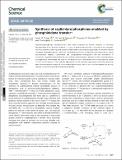Synthesis of acyl(chloro)phosphines enabled by phosphinidene transfer
Author(s)
Szkop, Kevin M.; Geeson, Michael B.; Stephan, Douglas W.; Cummins, Christopher C
DownloadPublished version (816.1Kb)
Terms of use
Metadata
Show full item recordAbstract
Acyl(chloro)phosphines RC(O)P(Cl)(t-Bu) have been prepared by formal insertion of tert-butyl phosphinidene (t-Bu-P) from t-BuPA (A = C14H10 or anthracene) into the C-Cl bond of acyl chlorides. We show that the under-explored acyl(chloro)phosphine functional group provides an efficient method to prepare bis(acyl)phosphines, which are important precursors to compounds used industrially as radical polymerization initiators. Experimental and computational investigations into the mechanism of formation of acyl(chloro)phosphines by our synthetic method reveal a pathway in which chloride attacks a phosphonium intermediate and leads to the reductive loss of anthracene from the phosphorus center in a P(v) to P(iii) process. The synthetic applicability of the acyl(chloro)phosphine functional group has been demonstrated by reduction to an acylphosphide anion, which can in turn be treated with an acyl chloride to furnish dissymmetric bis(acyl)phosphines.
Date issued
2019-02Department
Massachusetts Institute of Technology. Department of ChemistryJournal
Chemical Sicence
Publisher
Royal Society of Chemistry (RSC)
Citation
Szkop, Kevin M. et al. "Synthesis of acyl(chloro)phosphines enabled by phosphinidene transfer." Chemical Science 10, 12 (February 2019): 3627-3631 © 2019 The Royal Society of Chemistry
Version: Final published version
ISSN
2041-6520
2041-6539